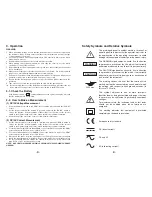
3. Operation
WARNING
1. When measuring voltage, be sure that the instrument is not connected or switched to
the resistance range. Always ensure that the correct terminals are used for the type
of measurement to be made.
2. Use extra care when measuring voltage above 50V, especially from sources where
high voltage is present.
3. Avoid making connections to live circuits whenever possible.
4. When making current measurements, be sure that the circuit is not live before
opening it to connect the test leads.
5. Before making resistance measurements or diode test, ensure that the circuit under
test is discharged.
6. Always ensure that the correct function and range is selected. If in doubt on which
range to use, start with the highest and work your way down.
7. Extreme care should be taken when using the instrument in conjunction with a current
transformer connected to the terminals if an open circuit occurs.
8. Ensure that the test leads and probes are in good condition with no damage to the
insulation.
9. Take care not to exceed the overload limits as shown in the specifications.
10. Before opening the case of the instrument to replace the battery, disconnect the test
leads from any external circuit, set the selector switch to the OFF position.
3-1. Check the Battery
If the battery is weak, a “ ” symbol will appear on the right of the display. It means
that the battery should be replaced.
3-2. How to Make a Measurement
(1) DC/AC Voltage Measurement
1. Connect the black test lead to the “COM” socket and the red test lead to the “V
W
CAP”
socket.
2. Set the selector switch to the desired “V” position, and press the “DC/AC” button to
choose the function. If the magnitude of the voltage is not known, set the selector
switch to the highest range and reduce until a satisfactory reading is obtained.
3. Connect the probes across the source or load under measurement.
(2) DC/AC Current Measurement
1. Set the selector switch to the desired “A” position, and press the “DC/AC” button to
choose the function. If the magnitude of the current is not known, set the selector
switch to the highest range and reduce until a satisfactory reading is obtained.
2. For current measurements less than 400mA, connect the black test lead to the “COM”
socket and the red test lead to the “
m
A/mA” socket.
3. For current measurements over 400mA, connect the black test lead to the “COM”
socket and the red test lead to the “10A” socket.
4. Disconnect the power from the circuit under test and open the normal circuit path
where the measurement is to be taken. Connect the meter in series with the circuit.
5. Do not continually measure 10A as the shunt wire will heat up. Allow 30 seconds
max. At 5A or less, continuous use is okay.
NOTE: BE SURE TO MEASURE WITHIN 30 SECONDS TO AVOID HIGH CURRENT
HAZARD.
Safety Symbols and Relative Symbols
This marking adjacent to another marking, terminal, or
operating device indicates that the operator must refer to
the explanation in the operating instructions to avoid
damage to the equipment and/or to avoid personal injury.
This WARNING sign denotes a hazard. It calls attention
to a procedure, practice or the like, which if not correctly
performed or adhered to, could result in personal injury.
This CAUTION sign denotes a hazard. It calls attention
to a procedure, practice or the like, which, if not correctly
adhered to, could result in damage to or destruction of
part or all of the instrument.
This marking advises the user that the terminal(s) so
marked must not be connected to a circuit point at which
the voltage, with respect to earth ground, exceeds (in
this case) 500 volts.
This symbol, adjacent to one or more terminals,
identifies them as being associated with ranges that may
in normal use be subjected to particularly hazardous
voltages.
For maximum safety, the instrument and its test leads
should not be handled when these terminals are
energized.
This marking indicates that equipment is protected
completely be the double insulation.
European safety standard.
DC (direct current).
DC and AC
AC (alternating current).
-3-
-6-
!
WARNING
CAUTION
500V max.
+






















